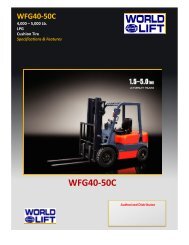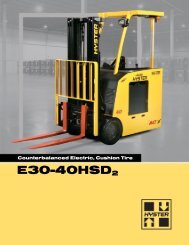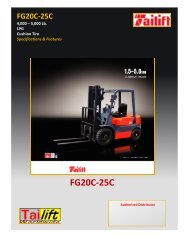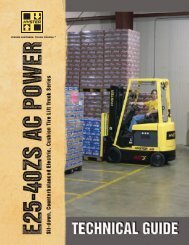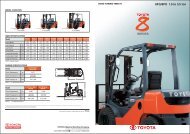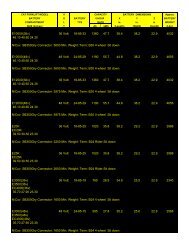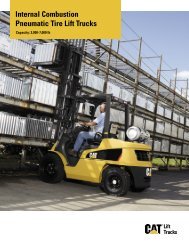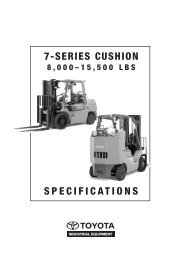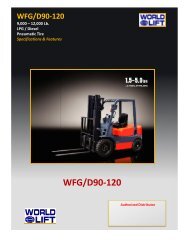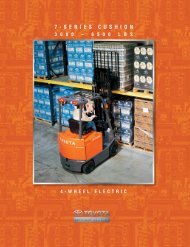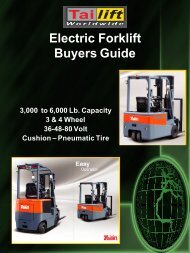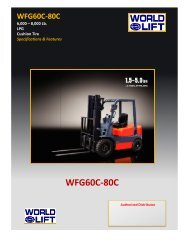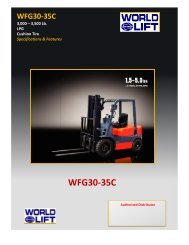Tailift Sales Manual - Worldwide Forklifts
Tailift Sales Manual - Worldwide Forklifts
Tailift Sales Manual - Worldwide Forklifts
You also want an ePaper? Increase the reach of your titles
YUMPU automatically turns print PDFs into web optimized ePapers that Google loves.
Indicated horsepower: The horse power developed in the cylinders, determined by the use of<br />
an indicator gauge. It does not include losses due to friction.<br />
Drawbar horsepower: The horsepower available to move a tractor and its load after deducting<br />
losses in the power train.<br />
Shaft, flywheel, brake horsepower: Actual horsepower produced by the engine after deducting<br />
the drag of accessories.<br />
Hydrostatic transmission: A transmission consisting of an engine driven variable displacement<br />
pump and motor providing infinitely variable speed control from zero to top speed without gears<br />
or clutches.<br />
Lifting speed: The upward speed of the forks either loaded or unloaded, expressed in feet per<br />
minute (fpm).<br />
Load capacity: The maximum load in pounds (or kilograms) that a truck can transport and/or<br />
stack to a specified height as rated by the manufacturer. Normally stated as a given load center,<br />
24 inches being the most common.<br />
Load center: The horizontal distance between the front vertical face of the forks and the<br />
longitudinal midpoint of an evenly distributed load. Note as the load center shifts forward<br />
(increases) the load capacity must be derated (decreased).<br />
Lowered overall height: The height of a mast in its most collapsed position; Either this<br />
dimension or possibly the height to the top of the overhead guard will determine through what<br />
passages, doorways, or under what obstructions a truck will pass.<br />
Lowering speed: The downward speed of the forks either loaded or unloaded, expressed in feet<br />
per minute (fpm).<br />
<strong>Manual</strong> transmission: A transmission employing gear trains and clutches engaged and shifted<br />
directly by an operator. It may employ up to five forward speeds.<br />
Maximum fork height: The ultimate surface height of the forks with the mast fully extended.<br />
Because of pallet or load overhang, stacking at precisely this height may not be possible.<br />
Maximum fork height, rated capacity: The ultimate height of a lift before the load must be<br />
derated. This list height is often accomplished with other than the standard mast.<br />
Minimum aisle, right angle stack: The smallest aisle width in which a truck can accomplish a<br />
right angle stacking procedure. Because some of a truck’s overall length (and the load itself) is<br />
ahead of the front wheels, the minimum aisle for a right angle stack need to be greater than the<br />
truck’s turning radius.<br />
Minimum aisle, right angle stack = turn radius + front overhang + load length + clearance.<br />
Outside turn radius: The radius of a circle with its center at the front wheel of the truck on the<br />
side of the truck towards which the truck is moving.<br />
2 <strong>Tailift</strong> <strong>Sales</strong> <strong>Manual</strong> 2005



